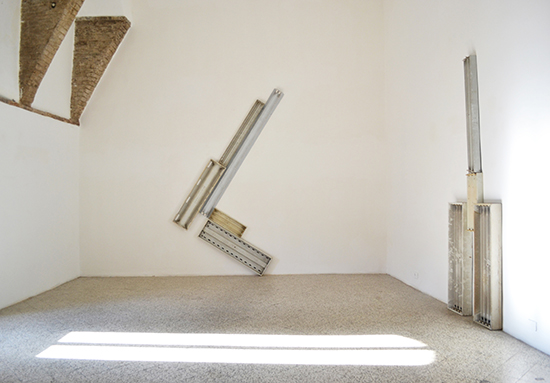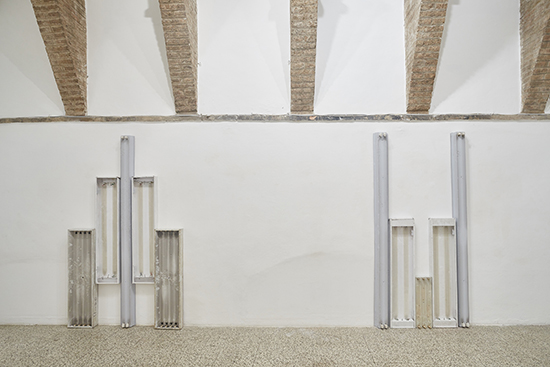Marcelo Cidade - un(monuments) for V.Tatlin

(Un)Monuments for V. Tatlin | exhibitions view Galleria Continua, San Gimignano | Courtesy: the artist and GALLERIA CONTINUA, San Gimignano / Beijing / Les Moulins / Habana | Photo by: Artnine
The ingredients:
The C.I.A behind the opening of the Museu de Arte de São Paulo.
Joseph Beuys smoking crack in downtown São Paulo.
The illusory innocence of modernist architecture, Brasilia and the dictatorship.
Gordon Matta Clark, Lygia Clark and Lina Bo Bardi.
Lenin's marxist propaganda and Dan Flavin minimalist.
Stirr them gently with a pinch of cement and get ready for a subversive Brazilian punch: Marcelo Cidade.
In 1920 a grand building was designed by artist and architect Vladimir Tatlin as monument and home of the Third International: iron, glass, steel for a colossal tower meant to help Lenin's marxist propaganda, a real technological hub for the political avantgarde, a spiral that would have been taller than the Eiffel Tower.
In 1964 American artist Dan Flavin initiated a series of 39 monuments to Tatlin, minimalist sets of pre-fabricated fluorescent tubes resembling the ambitious utopian shapes of the russian constructivist.
In 2015, in San Gimignano, at the Galleria Continua's Arco dei Becci, Brazilian artist Marcelo Cidade closes the loop of an appropriational short circuit, presenting a new series of sculptures made from off the grid flourescent light fittings, recovered structures of abandoned buildings in São Paulo, charged with the memory of the deterioration of their original spaces and meaning. No more light, no more enlightment, just ruins. Of Dan Flavin's homage to Tatlin, what remains, it is a critical reflection on utopian failures, and on monuments' anachronism.

We met Cidade and we talked about Brazilian modernism in architecture and its epic fails - with the exception of just a few, like Lina Bo Bardi and Flavio de Carvalho - about his sense of riappropriation and subversive critique of cultural hegemonic models, about his poetic language made from mundane materials, like cement and felt, about him going in and out the studio, on the road. Where it might happen to meet Joseph Beuys smoking crack......
Marcelo Cidade was born in 1979 in Sa?o Paulo, where he currently lives and works. Through an often subversive and informal practice, Cidade questions the ideals of modernist architecture and appropriates urban spaces. Comparing established social relations and values, Cidade produces an “aesthetics of resistance,” creating works that express complex social conflicts and bring signs and situations from the street into spaces given over to art. One of his particular interests is the public space generated in urban areas and the technological flux of our surveillance society.
Cidade has had solo exhibitions at Kadist Art Foundation, San Francisco (2014); Galleria Continua, San Gimignano, Italy (2015-2014); Casa França-Brasil, Rio de Janeiro (2013); Galeria Vermelho, São Paulo (2012, 2010, 2008, and 2006); Furini Arte Contemporanea, Rome (2010); and Centro Cultural São Paulo (CCSP) (2008); among others. He has participated in group exhibitions at the Museo Tamayo, Mexico City (2014); Wexner Center for the Arts, Columbus, Ohio (2014); Museu de Arte do Rio (MAR), Rio de Janeiro (2014); Museo d’Arte Moderna de São Paulo (2014, 2012, 2011, and 2010); the Broad Art Museum, East Lansing, Michigan (2013); the Krannert Art Museum, Champaign, Illinois (2103); CCA Wattis Institute for Contemporary Arts (2012); Tate Liverpool, England (2011); MUSAC - Castilla y Léon, Spain (2010); and the 27th São Paulo Biennial (2006); among others.
